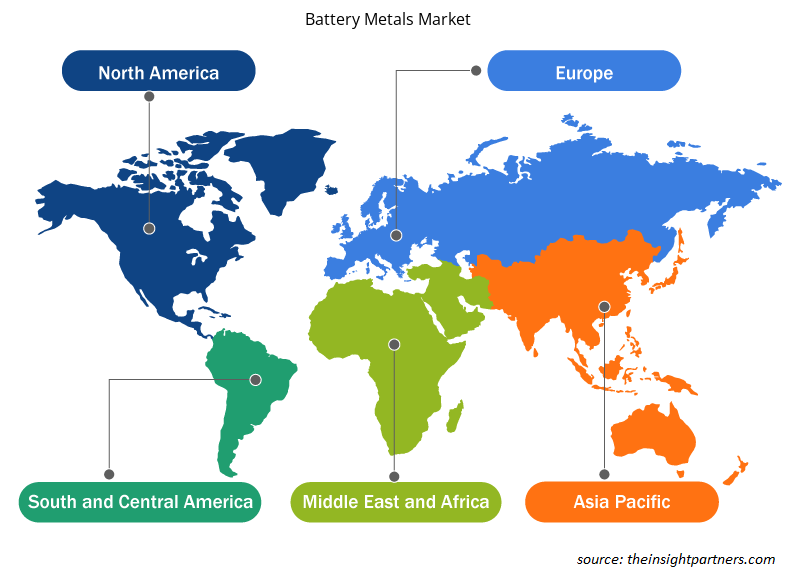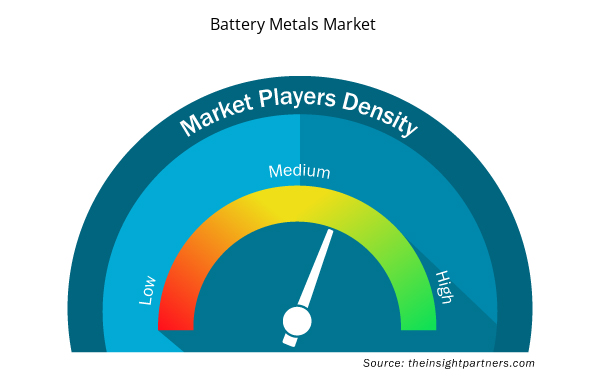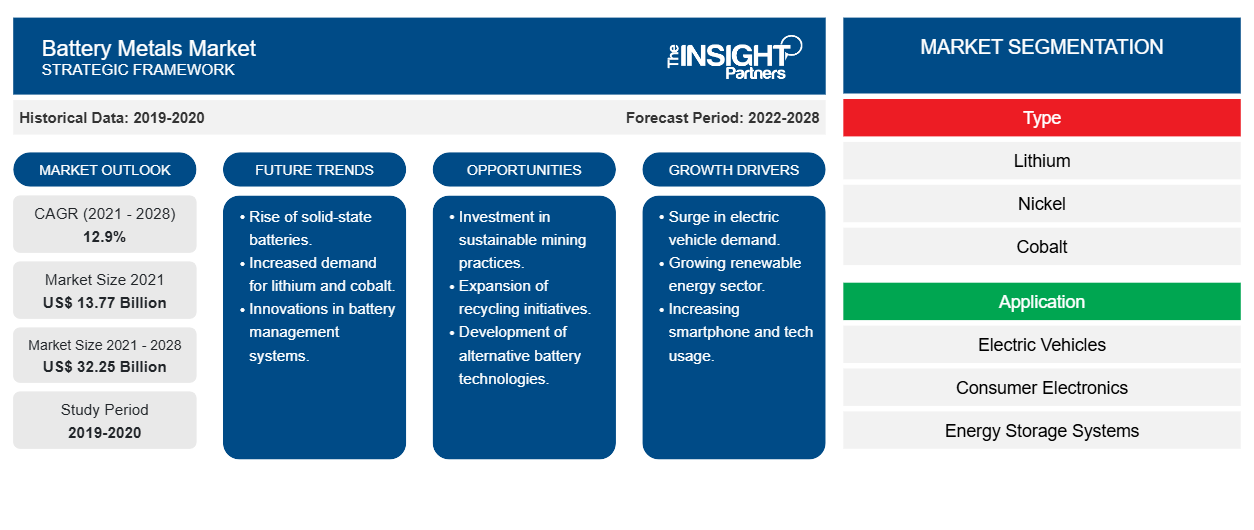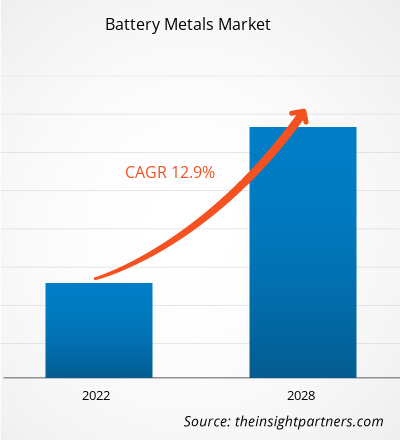[Informe de investigación] Se proyecta que el mercado de metales para baterías alcance los US$ 32.251,1 millones para 2028 desde los US$ 13.770,9 millones en 2021; se espera que crezca a una CAGR del 12,9% entre 2021 y 2028.
Los metales para baterías, como el litio, el cobalto, el níquel y el manganeso, se utilizan como materias primas en la fabricación de baterías. También se emplean en vehículos eléctricos, productos electrónicos de consumo y otras aplicaciones.
En 2020, Asia Pacífico tuvo la mayor participación en los ingresos del mercado mundial de metales para baterías . Varios países de Asia Pacífico están presenciando un auge en las industrias automotriz y electrónica, lo que probablemente seguirá impulsando el crecimiento del mercado de metales para baterías durante el período de pronóstico. Además, el mercado de vehículos eléctricos en APAC ha sido testigo de un crecimiento notable debido al sector automotriz y electrónico en rápida expansión.
Personalice este informe según sus necesidades
Obtendrá personalización en cualquier informe, sin cargo, incluidas partes de este informe o análisis a nivel de país, paquete de datos de Excel, así como también grandes ofertas y descuentos para empresas emergentes y universidades.
- Obtenga las principales tendencias clave del mercado de este informe.Esta muestra GRATUITA incluirá análisis de datos, desde tendencias del mercado hasta estimaciones y pronósticos.
La pandemia de COVID-19 provocó interrupciones en la cadena de suministro global. Muchas industrias, como la minería y la química y los materiales, se enfrentaron a desafíos sin precedentes para cumplir con los cronogramas de fabricación y entrega y las ventas de diversos bienes. Sin embargo, a medida que las economías planean reactivar sus operaciones, se espera que la demanda de metales para baterías aumente a nivel mundial. La reanudación de las operaciones en las industrias automotriz, electrónica y otras ha aumentado la necesidad de metales para baterías a nivel mundial. La industria de la electrónica de consumo se está expandiendo dinámicamente con el aumento en los gastos de los consumidores. Se espera que el aumento de la demanda de metales para baterías en diversas aplicaciones, como vehículos eléctricos, electrónica de consumo y sistemas de almacenamiento de energía, y las inversiones significativas de los fabricantes destacados impulsen el crecimiento del mercado de metales para baterías en los próximos años.
Perspectivas del mercado
Creciente industria de vehículos eléctricos
El aumento de la demanda de vehículos eléctricos a nivel mundial respalda el crecimiento del mercado de metales para baterías. Los productos a base de metales para baterías son ampliamente utilizados por la industria de vehículos eléctricos como reemplazo de la energía fósil necesaria para el funcionamiento de los vehículos. En áreas densamente pobladas, los vehículos eléctricos se utilizan ampliamente para reducir la contaminación de los vehículos, ya que el número de vehículos utilizados es mayor en dichas áreas. También es un factor importante para proporcionar diversificación energética y reducir la emisión de gases de efecto invernadero. Los beneficios de los vehículos eléctricos incluyen cero emisiones de escape, el potencial de reducción de emisiones de gases de efecto invernadero y una mejor eficiencia que los vehículos con motor de combustión interna.vehicels are widley used to reduce the vehicles pollution as number of vehicles used are more in such areas. It is also important factor for providing energy diversification and reducing greenhouse gas emission. Benefits of electric vehicles include zero tailpipe emissions, the potential for greenhouse gas emissions reductions, and better efficiency than internal combustion engine vehicles.
Los gobiernos de muchos países, entre ellos China, India y Estados Unidos, han aprobado normativas para fomentar la adopción de vehículos eléctricos. Los vehículos eléctricos y su mercado se están expandiendo significativamente debido al continuo progreso tecnológico en la electrificación de vehículos de dos y tres ruedas, autobuses y camiones.three-wheelers, buses, and trucks.
Según el informe de la Agencia Internacional de Energía 'The Global EV Outlook 2020', en 2019 se ha producido una expansión continua del stock mundial de vehículos eléctricos de pasajeros, que alcanzó los 7,2 millones de unidades, un 40 % más que en 2018. Debido a todos estos factores, la demanda de vehículos eléctricos/híbridos y vehículos eléctricos/híbridos enchufables está creciendo, lo que, a su vez, está impulsando sustancialmente el mercado de metales para baterías.EV Outlook 2020' report, there is continuous expansion in global stock of electric passenger vehicles in 2019, reaching 7.2 million units, 40% higher than in 2018. Due to all these factors, the demand for electric vehicles/hybrid and electric vehicles/plug-in hybrid vehicles is growing. This, in turn, is driving the battery metals market substantially.
Perspectivas basadas en tipos
Por tipo, el mercado de metales para baterías se subdivide en litio, níquel, cobalto y otros. El segmento de litio tuvo la mayor participación de mercado en 2020. El crecimiento del segmento se puede atribuir a la creciente aplicación del litio en la industria de los vehículos eléctricos y la electrónica debido a su propiedad de peso ligero.subsegmented into lithium, nickel, cobalt, and others. The lithium segment held the largest market share in 2020. The segment's growth can be attributed to the rising application of lithium in the electric vehicles and electronics industry due to its lightweight property.
Perspectivas basadas en aplicaciones
Según la aplicación, el mercado de metales para baterías se segmenta en vehículos eléctricos, productos electrónicos de consumo, sistemas de almacenamiento de energía y otros. El mercado de metales para baterías está dominado por el segmento de vehículos eléctricos, que registra la CAGR más alta durante el período de pronóstico. La creciente demanda de vehículos libres de contaminación debido al cambio en las normas regulatorias por parte de varias autoridades gubernamentales en los países desarrollados y en desarrollo está creando un gran impacto en el mercado de metales para baterías.
Albemarle Corporation; Umicore; LG Chem; Ganfeng Lithium Co., Ltd.; BASF SE; Bolt Metals Corp.; Honjo Metal Co., Ltd.; Lithium Australia NL; Vale; y Metso Outotec se encuentran entre los actores clave que operan en el mercado de metales para baterías. Estos actores del mercado se centran en el desarrollo de productos innovadores y de alta calidad para satisfacer los requisitos del cliente. Albemarle Corporation anunció el lanzamiento del Centro de Innovación de Materiales para Baterías (BMIC) en su sitio de Kings Mountain, Carolina del Norte. El laboratorio produjo tecnologías de ánodos de metal de litio que aumentaron la densidad energética de la batería mediante el uso de un laminado avanzado de metal de litio para lograr láminas de litio de 20 μm de espesor (es decir, aproximadamente una quinta parte del espesor promedio de un cabello humano) o más delgadas. Jiangsu Ganfeng Power Technology Co., Ltd., una subsidiaria de Ganfeng Lithium Industry, se mudó oficialmente a una nueva planta y mejoró la capacidad de producción mediante el reemplazo de equipos. Jiangsu Ganfeng ofrece sistemas de baterías de litio para vehículos industriales como su producto principal para beneficiar a los clientes con soluciones de sistemas de energía de larga duración, alta resistencia, libres de mantenimiento y personalizables, y facilita la iteración de vehículos industriales de baterías de plomo-ácido a baterías de hierro-litio.
Informe Destacado
- Tendencias progresivas de la industria en el mercado global de metales para baterías que ayudarán a los actores a desarrollar estrategias efectivas a largo plazo
- Estrategias de crecimiento empresarial adoptadas por los mercados desarrollados y en desarrollo
- Análisis cuantitativo del mercado mundial de metales para baterías de 2019 a 2028
- Estimación de la demanda de metales para baterías en diversas industrias
- Avances recientes para comprender el escenario competitivo del mercado y la demanda de vehículos eléctricos
- Tendencias y perspectivas del mercado junto con los factores que impulsan y restringen el crecimiento del mercado de metales para baterías
- Proceso de toma de decisiones mediante la comprensión de las estrategias que sustentan el interés comercial con respecto al crecimiento del mercado global de metales para baterías
- Tamaño del mercado de metales para baterías en varios nodos del mercado
- Descripción detallada y segmentación del mercado global de metales para baterías y su dinámica en la industria
- Tamaño del mercado de metales para baterías en varias regiones con oportunidades de crecimiento prometedoras
Perspectivas regionales del mercado de metales para baterías
Los analistas de Insight Partners explicaron en detalle las tendencias y los factores regionales que influyen en el mercado de metales para baterías durante el período de pronóstico. Esta sección también analiza los segmentos y la geografía del mercado de metales para baterías en América del Norte, Europa, Asia Pacífico, Oriente Medio y África, y América del Sur y Central.

- Obtenga datos regionales específicos para el mercado de metales para baterías
Alcance del informe sobre el mercado de metales para baterías
| Atributo del informe | Detalles |
|---|---|
| Tamaño del mercado en 2021 | US$ 13,77 mil millones |
| Tamaño del mercado en 2028 | US$ 32,25 mil millones |
| CAGR global (2021-2028) | 12,9% |
| Datos históricos | 2019-2020 |
| Período de pronóstico | 2022-2028 |
| Segmentos cubiertos | Por tipo
|
| Regiones y países cubiertos | América del norte
|
| Líderes del mercado y perfiles de empresas clave |
|
Densidad de actores del mercado: comprensión de su impacto en la dinámica empresarial
El mercado de metales para baterías está creciendo rápidamente, impulsado por la creciente demanda de los usuarios finales debido a factores como la evolución de las preferencias de los consumidores, los avances tecnológicos y una mayor conciencia de los beneficios del producto. A medida que aumenta la demanda, las empresas amplían sus ofertas, innovan para satisfacer las necesidades de los consumidores y aprovechan las tendencias emergentes, lo que impulsa aún más el crecimiento del mercado.
La densidad de actores del mercado se refiere a la distribución de las empresas o firmas que operan dentro de un mercado o industria en particular. Indica cuántos competidores (actores del mercado) están presentes en un espacio de mercado determinado en relación con su tamaño o valor total de mercado.
Las principales empresas que operan en el mercado de metales para baterías son:
- Corporación Albemarle
- Metales para pernos
- Compañía de litio Ganfeng, Ltd.
- Umicore
- LG Química
Descargo de responsabilidad : Las empresas enumeradas anteriormente no están clasificadas en ningún orden particular.

- Obtenga una descripción general de los principales actores clave del mercado de metales para baterías
Mercado de metales para baterías, por tipo
- Litio
- Níquel
- Cobalto
- Otros
Mercado de metales para baterías, por aplicación
- Vehículos eléctricos
- Electrónica de consumo
- Sistemas de almacenamiento de energía
- Otros
Perfiles de empresas
- Corporación Albemarle
- Umicore
- LG Química
- Compañía de litio Ganfeng, Ltd.
- BASF SE
- Corporación de metales Bolt.
- Compañía Metalúrgica Honjo, Ltd.
- Litio Australia NL
- Valle
- Metso Outotec
- Elementos americanos
- Análisis histórico (2 años), año base, pronóstico (7 años) con CAGR
- Análisis PEST y FODA
- Tamaño del mercado Valor/volumen: global, regional, nacional
- Industria y panorama competitivo
- Conjunto de datos de Excel



Report Coverage
Revenue forecast, Company Analysis, Industry landscape, Growth factors, and Trends

Segment Covered
This text is related
to segments covered.

Regional Scope
North America, Europe, Asia Pacific, Middle East & Africa, South & Central America

Country Scope
This text is related
to country scope.
Preguntas frecuentes
Rapid industrialization in developing countries such as China, India, Japan, and South Korea is expected to bolster the battery metal market growth. These countries are witnessing a rise in the consumption of electric vehicles, which is expected to increase the demand for battery metals in developing economies. Further, battery metals is extensively used in the electronics industry for batteries in electronics devices. Consumer batteries are commonly used to power small portable electronics like laptops, remote controls, cell phones, and other devices that need energy without a cord. Lithium-ion batteries are the most common high-capacity secondary batteries used in today’s power-hungry devices. In addition to this, battery metals is also used in energy storage systems. This is because lithium-ion batteries are the dominant storage technology for large-scale plants, allowing electricity grids to ensure a reliable renewable energy supply. Hence, the rising demand of batteries due to increase in manufacturing of electric vehicles and electronics devices is subsequently expected to increase the application of battery metals to manufacture these products, which will boost battery metals market growth.
The rising demand for electric vehicles globally is favoring the growth of the battery metals market. The electric vehicles industry is one of the major beneficiaries of battery metals products as the industry extensively uses batteries. The electric vehicle is an essential technology in terms of reducing air pollution in densely populated areas and a promising option for contribution in energy diversification and the reduction in greenhouse gas emission objectives. Various benefits of electric vehicles include zero tailpipe emissions, the potential for greenhouse gas emissions reductions, better efficiency than internal combustion engine vehicles, etc. Many countries, including China, India, and the US, have passed regulations to encourage the adoption of electric vehicles. Electric vehicles are expanding significantly as technological progress in the electrification of two/three-wheelers, buses, and trucks advances and their market grows. This, in turn, is driving the battery metals market substantially.
On the basis of application, the electric vehicles segment led the global battery metals market in 2020. The segment's growth can be attributed to the rising demand for electric vehicles globally. The rising initiatives by the government of various countries for adoption of pollution free vehicles and reduction of greenhouse gas emission is boosting the demand for battery based vehicles instead of fossil fuel based vehicles. Thus, the factors mentioned above are propelling the growth of the electric vehicles segment of the battery metals market growth.
The major players operating in the global battery metals market are Albemarle Corporation, Umicore, LG Chem, Ganfeng Lithium Co., Ltd.; BASF SE, Bolt Metals Corp., Honjo Metal Co., Ltd.; Lithium Australia NL, Vale and Metso Outotec
In 2020, Asia Pacific held the largest revenue share of the global battery metals market. The various countries from the Asia Pacific region are witnessing an upsurge due to growth in automotive and electronics industries which is fueling the battery metals market growth during the forecast period. Further, the market for electric vehicles across APAC has witnessed notable growth owing to the rapidly expanding automotive industry, growth of the electronics sector, and rising government initiatives about sustainable technology solutions across the region. This is further expected to contribute to the battery metals market growth in the region.
Based on type, the lithium segment led the global battery metals market in 2020. The segment's growth can be attributed to the rising application of lithium in the battery manufacturing. The segment's growth can be attributed the rising application of lithium in the electric vehicles and electronics industry. Lithium is a light weight metal and finds its application in batteries used for vehicles and electronics devices. The lithium ion batteries are highly consumed batteries in the end use industry. Due to property of being light weight segment, the segment finds applications in electric vehicles, electronics, and energy storage systems.
Trends and growth analysis reports related to Chemicals and Materials : READ MORE..
The List of Companies - Battery Metals Market
- Albemarle Corporation
- Bolt Metals
- Ganfeng Lithium Co.,Ltd.
- Umicore
- LG Chem
- Honjo Metal Co., Ltd.
- Vale
- Lithium Australia NL
- BASF SE
- Metso Outotec
The Insight Partners performs research in 4 major stages: Data Collection & Secondary Research, Primary Research, Data Analysis and Data Triangulation & Final Review.
- Data Collection and Secondary Research:
As a market research and consulting firm operating from a decade, we have published and advised several client across the globe. First step for any study will start with an assessment of currently available data and insights from existing reports. Further, historical and current market information is collected from Investor Presentations, Annual Reports, SEC Filings, etc., and other information related to company’s performance and market positioning are gathered from Paid Databases (Factiva, Hoovers, and Reuters) and various other publications available in public domain.
Several associations trade associates, technical forums, institutes, societies and organization are accessed to gain technical as well as market related insights through their publications such as research papers, blogs and press releases related to the studies are referred to get cues about the market. Further, white papers, journals, magazines, and other news articles published in last 3 years are scrutinized and analyzed to understand the current market trends.
- Primary Research:
The primarily interview analysis comprise of data obtained from industry participants interview and answers to survey questions gathered by in-house primary team.
For primary research, interviews are conducted with industry experts/CEOs/Marketing Managers/VPs/Subject Matter Experts from both demand and supply side to get a 360-degree view of the market. The primary team conducts several interviews based on the complexity of the markets to understand the various market trends and dynamics which makes research more credible and precise.
A typical research interview fulfils the following functions:
- Provides first-hand information on the market size, market trends, growth trends, competitive landscape, and outlook
- Validates and strengthens in-house secondary research findings
- Develops the analysis team’s expertise and market understanding
Primary research involves email interactions and telephone interviews for each market, category, segment, and sub-segment across geographies. The participants who typically take part in such a process include, but are not limited to:
- Industry participants: VPs, business development managers, market intelligence managers and national sales managers
- Outside experts: Valuation experts, research analysts and key opinion leaders specializing in the electronics and semiconductor industry.
Below is the breakup of our primary respondents by company, designation, and region:

Once we receive the confirmation from primary research sources or primary respondents, we finalize the base year market estimation and forecast the data as per the macroeconomic and microeconomic factors assessed during data collection.
- Data Analysis:
Once data is validated through both secondary as well as primary respondents, we finalize the market estimations by hypothesis formulation and factor analysis at regional and country level.
- Macro-Economic Factor Analysis:
We analyse macroeconomic indicators such the gross domestic product (GDP), increase in the demand for goods and services across industries, technological advancement, regional economic growth, governmental policies, the influence of COVID-19, PEST analysis, and other aspects. This analysis aids in setting benchmarks for various nations/regions and approximating market splits. Additionally, the general trend of the aforementioned components aid in determining the market's development possibilities.
- Country Level Data:
Various factors that are especially aligned to the country are taken into account to determine the market size for a certain area and country, including the presence of vendors, such as headquarters and offices, the country's GDP, demand patterns, and industry growth. To comprehend the market dynamics for the nation, a number of growth variables, inhibitors, application areas, and current market trends are researched. The aforementioned elements aid in determining the country's overall market's growth potential.
- Company Profile:
The “Table of Contents” is formulated by listing and analyzing more than 25 - 30 companies operating in the market ecosystem across geographies. However, we profile only 10 companies as a standard practice in our syndicate reports. These 10 companies comprise leading, emerging, and regional players. Nonetheless, our analysis is not restricted to the 10 listed companies, we also analyze other companies present in the market to develop a holistic view and understand the prevailing trends. The “Company Profiles” section in the report covers key facts, business description, products & services, financial information, SWOT analysis, and key developments. The financial information presented is extracted from the annual reports and official documents of the publicly listed companies. Upon collecting the information for the sections of respective companies, we verify them via various primary sources and then compile the data in respective company profiles. The company level information helps us in deriving the base number as well as in forecasting the market size.
- Developing Base Number:
Aggregation of sales statistics (2020-2022) and macro-economic factor, and other secondary and primary research insights are utilized to arrive at base number and related market shares for 2022. The data gaps are identified in this step and relevant market data is analyzed, collected from paid primary interviews or databases. On finalizing the base year market size, forecasts are developed on the basis of macro-economic, industry and market growth factors and company level analysis.
- Data Triangulation and Final Review:
The market findings and base year market size calculations are validated from supply as well as demand side. Demand side validations are based on macro-economic factor analysis and benchmarks for respective regions and countries. In case of supply side validations, revenues of major companies are estimated (in case not available) based on industry benchmark, approximate number of employees, product portfolio, and primary interviews revenues are gathered. Further revenue from target product/service segment is assessed to avoid overshooting of market statistics. In case of heavy deviations between supply and demand side values, all thes steps are repeated to achieve synchronization.
We follow an iterative model, wherein we share our research findings with Subject Matter Experts (SME’s) and Key Opinion Leaders (KOLs) until consensus view of the market is not formulated – this model negates any drastic deviation in the opinions of experts. Only validated and universally acceptable research findings are quoted in our reports.
We have important check points that we use to validate our research findings – which we call – data triangulation, where we validate the information, we generate from secondary sources with primary interviews and then we re-validate with our internal data bases and Subject matter experts. This comprehensive model enables us to deliver high quality, reliable data in shortest possible time.


 Obtenga una muestra gratuita de este informe
Obtenga una muestra gratuita de este informe